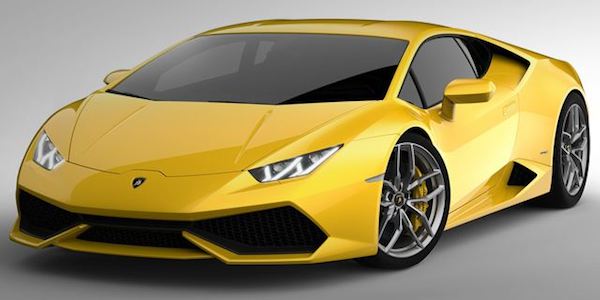The Lamborghini Gallardo has soldiered valiantly for the last several years of its decade-long run, with special edition upon special edition making the very most out of its now aged platform. But the Gallardo’s time has come. A new Lamborghini has arrived. The Huracán.
To be precise, it’s the Huracán LP 610-4. As you suspect, the 610 references the car’s horsepower, though as usual, it’s metric, so the American horsepower figure is closer to 600. Nevertheless, the 5.2-liter V-10 that produces the power, which arrives at a screaming 8,250 rpm, now benefits from direct fuel injection and also generates 480 pound-feet of torque.
In the Huracán’s 3,140-pound chassis, that 600-horsepower V-10 is, as predicted, matched to a seven-speed dual-clutch transmission and capable of accelerating you to 62 mph in just 3.2 seconds–a figure that’s likely to brush against the 3.0-second mark in the real world when the measure is 60 mph. Keeping your foot to the floor, 124 mph arrives in 9.9 seconds, and, if you have the nerves–and the nearly limitless closed course–for it, the Huracán will carry on to a top speed of more than 202 mph.
But perhaps just as important as the Huracán’s performance figures is the car’s appearance. It’s impossible not to see the influence of the Huracán’s older, larger brother, the Aventador. But at the same time, the Huracán is clearly its own car, with proportions and details setting it apart. At any rate, it’s much more closely aligned with the modern Lamborghini design image than was the Gallardo.
Up front, full LED headlamps create the illumination, and are standard equipment on every Huracán. But then, every exterior light on the new Lamborghini is LED–a first for the entire compact supercar segment, according to the company.
Comfort may be relative when you’re talking about a supercar, but the Huracán offers three core models for its driving dynamics system: Strada, Sport, and Corsa. Each mode is progressively more aggressive in its tuning of the Lamborghini Doppia Frizione (LDF) seven-speed dual-clutch gearbox’s behavior, the engine’s throttle mapping, the dynamic exhaust, the four-wheel drive system, and the electronic stability control. Optional Lamborhini Dynamic Steering and magneto-rheological dampers round out the dynamic elements of the Huracán’s driver interface, also adjusted by the three core dynamic settings. Carbon-ceramic brakes are standard on all Huracáns.
So what about that name, Huracán? Like all Lamborghinis of recent vintage, the Huracán is named after a Spanish fighting bull. This one is from the Conte de la Patilla line, and, according to Lamborghini, was known for his “outstanding courage and strong sense of attack.” That’s a sentiment we can surely get behind.
The Huracán LP 610-4 will make its global debut at the 2014 Geneva Motor Show next March and then will be available in several car market, but in the meantime, Lamborghini is planning over 130 private previews of the car in 60 cities around the world.
Lamborghini will build the Huracán on a brand-new line at its Sant’Agata Bolognese plant, with the first cars reaching customers in the spring of 2014.


![03_Lamborghini-Huracán-LP-610-4-vert-800x904[1]](http://18.202.54.69/wp-content/uploads/2013/12/03_Lamborghini-Huracán-LP-610-4-vert-800x9041.jpg)

